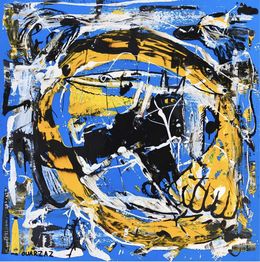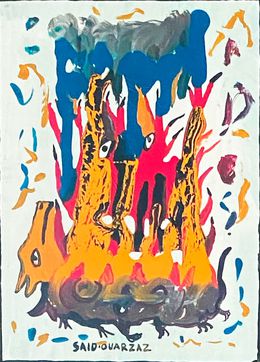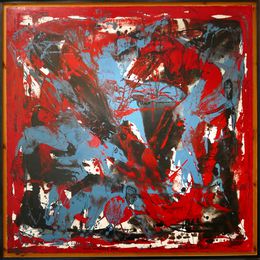
Presentation
The genius of Saïd Ouarzaz
In 1996, Frédéric Damgaard, this great talents scout of the city of Essaouira exhibited Saïd Ouarzaz. He then described his painting as being “gestural” and “dazzling”, “immediate”. Today we are presented with this primordial strength again. This self-taught painter has created a unique universe from his almost animist ancestral representations. Ouarzaz is not the thread of history, he is both beneath and beyond history as his peers Tabal, Baki, Maimoun or Ben Ali, but with something so peculiar that it would not be possible to talk of Art Brut or Naïve Art.
A School of Essaouira school or singular artists ?
Ouarzaz is related to a phenomenon that raises perplexity and often referred as the School of Essaouira. According to Mickaël Faure, there is no such thing as the School of Essaouira, but rather an « artistic community of Essaouira », the one of artists referred to as “singular” which is an informal community of strange and quirky creators highly individualistic, foreign to the usual circuit of art and to its codes, its arcanes and multiple protagonists. The same critic mentions “some common denominators beyond a logical diversity of forms”. For instance, the colored dot, so peculiar of a powerful pictural way in Essaouira {…} a way of painting the dot more consistent with African or Aboriginal art {…}, the color so various and present, as a master, {and forms}, rhythms and their motifs often repeated and audacious : similar to entangled and continuous curbs, lines or overlays of distorted figures that intermingle”. The painting of Ouarzaz indeed asserts itself in this trend with its animal and vegetal figures inspired but not reduced by a peasant universe.
“The art, it’s the earth !”
Ouarzaz comes with no doubt from a southern Moroccan soil and belongs to our times. However he seems to escape classifications. To join Ouarzaz family, one has to enter the backcountry of Essaouira where the trade winds don’t get to. We even left the argan trees to drive into semi-arid landscapes. Wadis are dry. Earth is gullied. At the end of the path, we eventually went by foot on these Berber edges in a sweltering heat. A donkey appeared. It showed us the way with its swinging tail setting the pace of a time that no longer was ours. Altogether felt from our shoulders the weight of our schedules, and our appointments. We had to abandon the straight line for a winding course and enter another space-time. Ouarzaz house is simple and harsh to get shelter from the climate, welcome the family and friends and work. The hospitality is infinite. This simplicity, the strength of the social bonds, the nearness of the earth, the lack of artistic or school education, specifically, make them close of the Australian aboriginal to whom we owe the formula : “The art, it’s the earth !”
The time of the dream.
“Referring to the aboriginal people, Marcia Langton, uses the term “the people of artists”. “{To them}, art is essential. It gives basis to {their} identity, {their} relationship with earth : there lies the secret of {their} survival. {Their} symbolic world always gave structure to {their} society”. The same author adds “Earth is the beaux-arts. The more humanity will have consciousness of it, the better it will hold the living society in harmony”. These works belong to “the time of the dream”. “Dream” on aboriginal soil is the generic name of paintings and sculptures. For “every dream is regularly painted or sculpted”. The objects that we find in some of aboriginal exhibitions such as shields, propellers, stone-knives, caps and mother-of-pearl shells, illustrate the continuum between past, present and future, which is a core concept to the art and culture of the western desert and to Tjukurrpa (the time of the dream) ». Peasant-painter, Ouarzaz, also paints dreams as trances and lives in the time of the earth. Only where paintings are titles of ownership, and in the name of a centuries-old tradition, and are recognized in justice, Ouarzaz asserts his own truly work of art.
In Ouarzaz’ paintings one often finds demons figures, in the sense of a familiar genius, half-man, half-animal, as a spirit that go with us. Socrates had his daimôn who uttered some answers. Plato, in Symposium, comes back to these beings intermediating between men and gods and thanks to whom divination and magic are made possible. Some of those beings are seen dancing in Tabal’s works. Ouarzaz’ daimôn is stronger, taller. He can invade all the canvas and take the spectator with him. The strength of Ouarzaz’ work derives from this telluric genius. It’s him driving us to a world that seems close to Jackson Pollock’s. When Pollock starts from the western art to get to the Amerindians’ cosmogony. Ouarzaz starts from his soil to get to the an abstraction which plays along with dripping and renewed technics (dilutions, stains, overlays).
In his cosmogony, there is room for geniuses and a certain modernity. The traces of tradition slowly disappear and are drawn into a dizzying swirl made of colors, but the initial energy is not undone. This Dionysian genius is sometimes figured, but always present.
It’s Ouarzaz’ genius that leads the dance.
- Alexandre Pajon
Read more
In 1996, Frédéric Damgaard, this great talents scout of the city of Essaouira exhibited Saïd Ouarzaz. He then described his painting as being “gestural” and “dazzling”, “immediate”. Today we are presented with this primordial strength again. This self-taught painter has created a unique universe from his almost animist ancestral representations. Ouarzaz is not the thread of history, he is both beneath and beyond history as his peers Tabal, Baki, Maimoun or Ben Ali, but with something so peculiar that it would not be possible to talk of Art Brut or Naïve Art.
A School of Essaouira school or singular artists ?
Ouarzaz is related to a phenomenon that raises perplexity and often referred as the School of Essaouira. According to Mickaël Faure, there is no such thing as the School of Essaouira, but rather an « artistic community of Essaouira », the one of artists referred to as “singular” which is an informal community of strange and quirky creators highly individualistic, foreign to the usual circuit of art and to its codes, its arcanes and multiple protagonists. The same critic mentions “some common denominators beyond a logical diversity of forms”. For instance, the colored dot, so peculiar of a powerful pictural way in Essaouira {…} a way of painting the dot more consistent with African or Aboriginal art {…}, the color so various and present, as a master, {and forms}, rhythms and their motifs often repeated and audacious : similar to entangled and continuous curbs, lines or overlays of distorted figures that intermingle”. The painting of Ouarzaz indeed asserts itself in this trend with its animal and vegetal figures inspired but not reduced by a peasant universe.
“The art, it’s the earth !”
Ouarzaz comes with no doubt from a southern Moroccan soil and belongs to our times. However he seems to escape classifications. To join Ouarzaz family, one has to enter the backcountry of Essaouira where the trade winds don’t get to. We even left the argan trees to drive into semi-arid landscapes. Wadis are dry. Earth is gullied. At the end of the path, we eventually went by foot on these Berber edges in a sweltering heat. A donkey appeared. It showed us the way with its swinging tail setting the pace of a time that no longer was ours. Altogether felt from our shoulders the weight of our schedules, and our appointments. We had to abandon the straight line for a winding course and enter another space-time. Ouarzaz house is simple and harsh to get shelter from the climate, welcome the family and friends and work. The hospitality is infinite. This simplicity, the strength of the social bonds, the nearness of the earth, the lack of artistic or school education, specifically, make them close of the Australian aboriginal to whom we owe the formula : “The art, it’s the earth !”
The time of the dream.
“Referring to the aboriginal people, Marcia Langton, uses the term “the people of artists”. “{To them}, art is essential. It gives basis to {their} identity, {their} relationship with earth : there lies the secret of {their} survival. {Their} symbolic world always gave structure to {their} society”. The same author adds “Earth is the beaux-arts. The more humanity will have consciousness of it, the better it will hold the living society in harmony”. These works belong to “the time of the dream”. “Dream” on aboriginal soil is the generic name of paintings and sculptures. For “every dream is regularly painted or sculpted”. The objects that we find in some of aboriginal exhibitions such as shields, propellers, stone-knives, caps and mother-of-pearl shells, illustrate the continuum between past, present and future, which is a core concept to the art and culture of the western desert and to Tjukurrpa (the time of the dream) ». Peasant-painter, Ouarzaz, also paints dreams as trances and lives in the time of the earth. Only where paintings are titles of ownership, and in the name of a centuries-old tradition, and are recognized in justice, Ouarzaz asserts his own truly work of art.
In Ouarzaz’ paintings one often finds demons figures, in the sense of a familiar genius, half-man, half-animal, as a spirit that go with us. Socrates had his daimôn who uttered some answers. Plato, in Symposium, comes back to these beings intermediating between men and gods and thanks to whom divination and magic are made possible. Some of those beings are seen dancing in Tabal’s works. Ouarzaz’ daimôn is stronger, taller. He can invade all the canvas and take the spectator with him. The strength of Ouarzaz’ work derives from this telluric genius. It’s him driving us to a world that seems close to Jackson Pollock’s. When Pollock starts from the western art to get to the Amerindians’ cosmogony. Ouarzaz starts from his soil to get to the an abstraction which plays along with dripping and renewed technics (dilutions, stains, overlays).
In his cosmogony, there is room for geniuses and a certain modernity. The traces of tradition slowly disappear and are drawn into a dizzying swirl made of colors, but the initial energy is not undone. This Dionysian genius is sometimes figured, but always present.
It’s Ouarzaz’ genius that leads the dance.
- Alexandre Pajon
All artworks of Said Ouarzaz
Discover our selections of works by artists
Need help finding your favorite? Consult our selection pages made for you.
Need to know more?
What are their 3 main works?
What is Said Ouarzaz’s artistic movement?
The artistic movements of the artists are: Gestural abstraction
When was Said Ouarzaz born?
The year of birth of the artist is: 1965

















